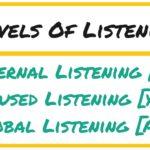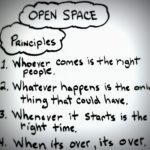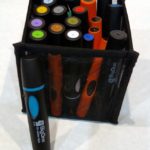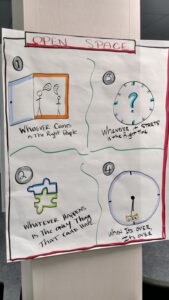 Open Space was inspired by the hallway conversations that occurred at traditional conferences. Open Space needs people who will propose and host sessions. The question is: if you’re attending an Open Space event, should YOU host a session?
Open Space was inspired by the hallway conversations that occurred at traditional conferences. Open Space needs people who will propose and host sessions. The question is: if you’re attending an Open Space event, should YOU host a session?
Facilitation
How to Facilitate a Large Open Space Event

Open Space events can be a great way to organize a large group of people to quickly and effectively address the issues that matter to them. People often leave amazed at how much they learned or accomplished, especially when the event started with an empty agenda. You probably loved an event you attended and now are wondering how to facilitate open space with a large group. Open space can be used within a company or community conference.
Jake and I have both facilitated open space events with 100-1000+ attendees. There is a lot of preparation that goes into making the event go smoothly—in advance of the event and the day-of. There’s more to facilitating open space than walking around a circle and explaining the principles!
Working with Group Tensions

Last October, I helped the Agile Alliance Board of Directors with their quarterly meeting. They asked me to write up one of the ways we worked with some difficulties that came up.
Global Listening When Remote
Many people are working from home at this point and this will obviously continue for a while. Many organizations had already been working remote. I’ve worked on a number of remote teams and with a number of remote organizations well before the current situation we are in. I’ve done remote work as a coach, trainer, product manager, and team member well before the current situation we are in. Each of those instances I found myself enjoying some aspects of the work and also wishing for aspects to be in person. One of the most challenging things to do remotely is to listen.
Proposing Open Space Technology Sessions
When I am at conferences or events being run using Open Space Technology (learn more about attendee driven conferences), people often ask me “should I propose a open space session?” As we get into the discussion I tend to ask the same core questions:
- Are you passionate about the topic?
- Are you clear enough on what the topic is?
- What would your 30-second pitch and summary of the topic to propose at the marketplace?
- Are you comfortable hosting the session or, if not, is there 1 or 2 more that might help you?
Open Space Conferences & Events – Created by Attendees!
Open Space Conferences, Events, and Workshops are one of my favorites ways to learn. Many people have never had the opportunity to experience an Open Space Event or even know what it is. I hope you can learn more about Open Space and even attend an event and experience the amazingness!
Imagine walking into a large conference or event room with 100 or 1500 people. You look around the room and know only a few people. You see a blank wall with time slots and room names on it.
 Two facilitators kick the event off. They explain a light structure for success, a few core principles, and create a fun energy in this large room. They invite anyone in the room (including you) to propose a session on a topic that is of value to them. Simply step up to the microphone and propose a session. You can’t imagine proposing a session, but plenty of other people are. The person sitting next to you stands up and heads over to the mic to propose a session. You notice that blank wall of time slots filling up with a variety of session topics! Next thing you know, you are in line proposing a session! Wait – what happened! As the time to propose sessions is up, there is now a large wall (or marketplace) of sessions to choose from. You decide on a session to attend in the 1st time slot and head over to that session ready to learn and contribute! And still a bit surprised that this worked!
Two facilitators kick the event off. They explain a light structure for success, a few core principles, and create a fun energy in this large room. They invite anyone in the room (including you) to propose a session on a topic that is of value to them. Simply step up to the microphone and propose a session. You can’t imagine proposing a session, but plenty of other people are. The person sitting next to you stands up and heads over to the mic to propose a session. You notice that blank wall of time slots filling up with a variety of session topics! Next thing you know, you are in line proposing a session! Wait – what happened! As the time to propose sessions is up, there is now a large wall (or marketplace) of sessions to choose from. You decide on a session to attend in the 1st time slot and head over to that session ready to learn and contribute! And still a bit surprised that this worked!
Is Your Training Amazing & Engaging? Or Does it Smell?
I find many things puzzling. One that is puzzling, frustrating, and annoying is how people continue to use outdated methods to train.
Marker Fanatics & Facilitating with Great Markers!
Great markers provide you with the option to create many different types of charts, diagrams, and pictures in your training or facilitated sessions. If you don’t use markers in your sessions, that might be a sign you need to make some changes!
Why Project Retrospectives Are Challenging
Project retrospectives are challenging. I spoke a bit about this in lessons learned vs. project retrospectives. You might look at a merger, acquisition, implementation of a new ERP system, or even a major upgrade of an ERP or CRM system. These are non-reoccurring events. A retrospective of this type is quite different from a typical agile retrospective, primarily because on this type of project, people will change and the project will not repeat (the definition of a project is that it is a unique endeavor). At issue here is the fact that if the people will not be the same and the project does not reoccur – then they can’t come up with actions they will apply right away based on what they learned. Ideas for change often just end up in a spreadsheet, a book shelf, or some electronic tool. A big book of “lessons learned” that sits on the shelf gathering dust does not provide much, if any, value.
Agile Safari – What’s Not Being Said?
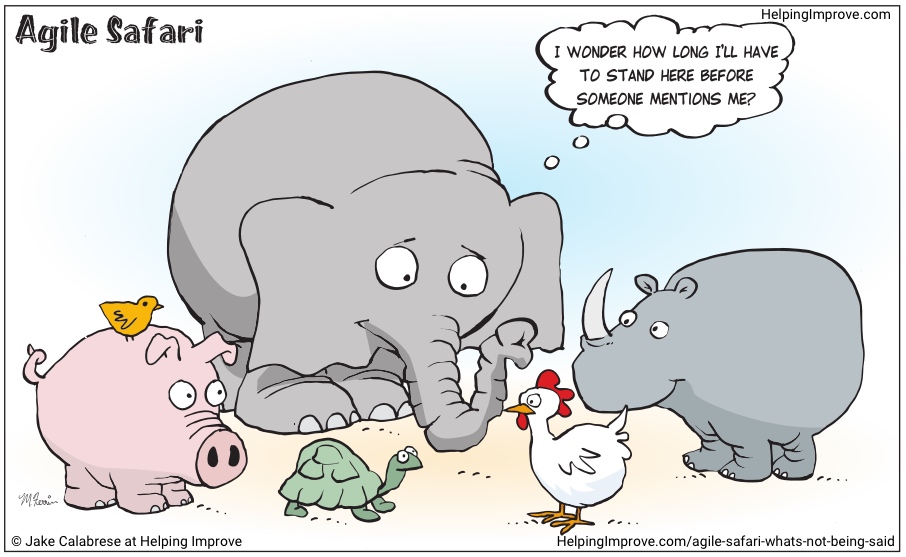
Have you been in a situation where no one would bring up the problem that everyone knew was “in the room?” I’d guess that everyone has been there. So often, we don’t bring up the “elephant in the room.” For anyone who has not heard of this, the elephant in the room is a saying for the real or obvious truth that is not being addressed. Given an elephant in a room would be hard to miss, when people ignore it, they are typically pretending it is not there.


